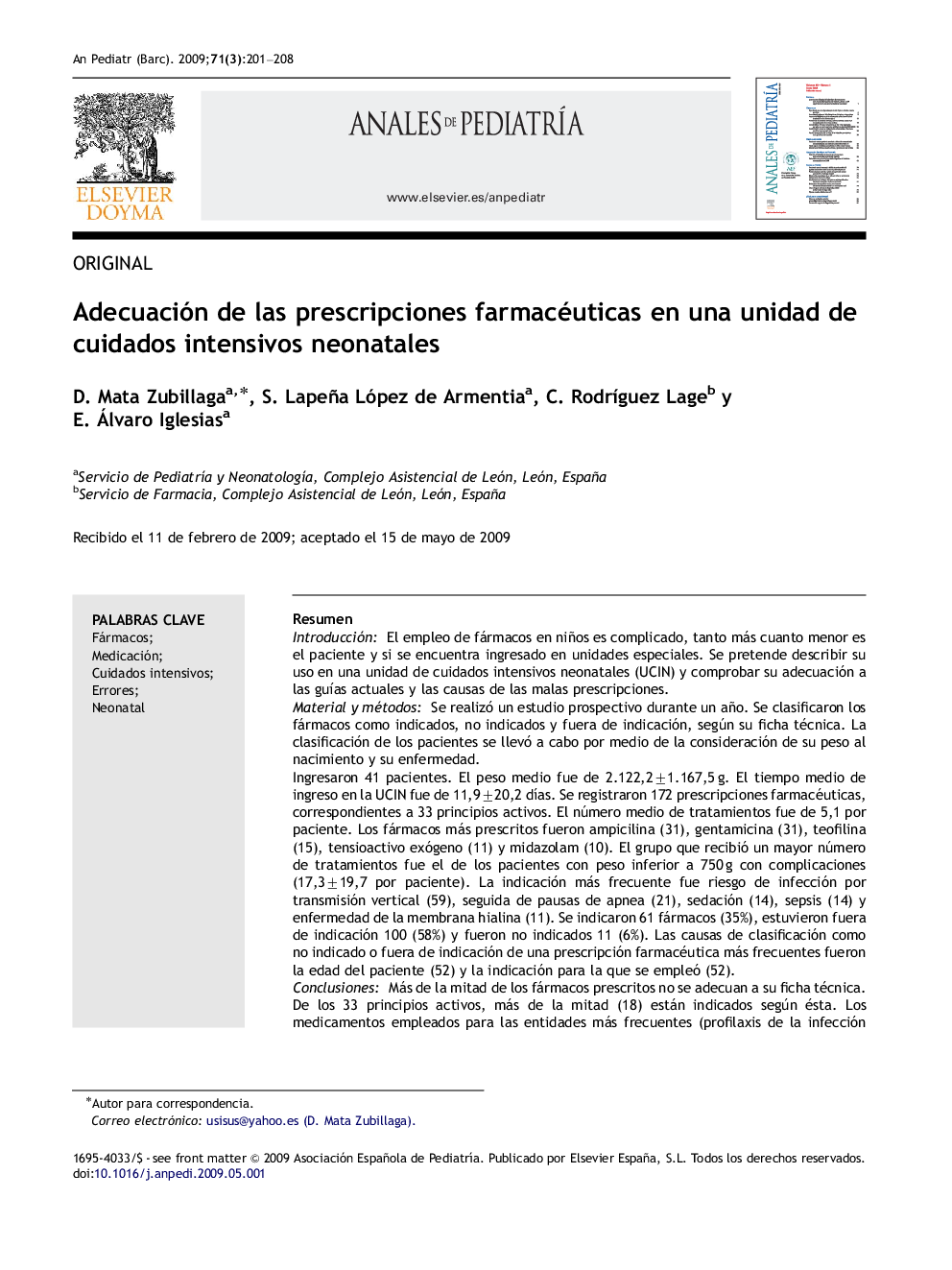| کد مقاله | کد نشریه | سال انتشار | مقاله انگلیسی | نسخه تمام متن |
|---|---|---|---|---|
| 4143603 | 1272413 | 2009 | 8 صفحه PDF | دانلود رایگان |

ResumenIntroducciónEl empleo de fármacos en niños es complicado, tanto más cuanto menor es el paciente y si se encuentra ingresado en unidades especiales. Se pretende describir su uso en una unidad de cuidados intensivos neonatales (UCIN) y comprobar su adecuación a las guías actuales y las causas de las malas prescripciones.Material y métodosSe realizó un estudio prospectivo durante un año. Se clasificaron los fármacos como indicados, no indicados y fuera de indicación, según su ficha técnica. La clasificación de los pacientes se llevó a cabo por medio de la consideración de su peso al nacimiento y su enfermedad.Ingresaron 41 pacientes. El peso medio fue de 2.122,2±1.167,5 g. El tiempo medio de ingreso en la UCIN fue de 11,9±20,2 días. Se registraron 172 prescripciones farmacéuticas, correspondientes a 33 principios activos. El número medio de tratamientos fue de 5,1 por paciente. Los fármacos más prescritos fueron ampicilina (31), gentamicina (31), teofilina (15), tensioactivo exógeno (11) y midazolam (10). El grupo que recibió un mayor número de tratamientos fue el de los pacientes con peso inferior a 750 g con complicaciones (17,3±19,7 por paciente). La indicación más frecuente fue riesgo de infección por transmisión vertical (59), seguida de pausas de apnea (21), sedación (14), sepsis (14) y enfermedad de la membrana hialina (11). Se indicaron 61 fármacos (35%), estuvieron fuera de indicación 100 (58%) y fueron no indicados 11 (6%). Las causas de clasificación como no indicado o fuera de indicación de una prescripción farmacéutica más frecuentes fueron la edad del paciente (52) y la indicación para la que se empleó (52).ConclusionesMás de la mitad de los fármacos prescritos no se adecuan a su ficha técnica. De los 33 principios activos, más de la mitad (18) están indicados según ésta. Los medicamentos empleados para las entidades más frecuentes (profilaxis de la infección vertical, pausas de apnea, sepsis y sedación) no son adecuados según lo expuesto en su ficha técnica.
IntroductionThe employment of medicaments in children is complicated, so much more minor all that is the patient and if it is deposited in special units. We try to describe their use in a neonatal intensive care unit, to verify their adequacy with regard to the current guides and the reasons of the wrong prescriptions.Mterial and methodsA market study was realized for one year. One classified the medicaments as indicated, not indicated and out of indication, according to their specification sheet. The classification of the patients was carried out considering their weight to the birth and pathology.41 patients entered. The average weight was 2122,2±1167,5 g. The average time of revenue in neonatal intensive care unit was 11,9±20,2 days. There were registered 172 pharmaceutical prescriptions, corresponding 33 active principles. The average number of treatments was of 5,1 for patient. The most prescribed medicaments were ampiciline (31), gentamicine (31), teofiline (15), surfactant exogenous (11) and midazolam (10). The group that received more treatments was that of minors of 750 g. with complications (17,3±19,7 for patient). The most frequent indication was a risk of infection for vertical transmission (59), followed of pauses of apnea (21), sedation (14), sepsis (14) and hyaline membrane disease (11). Were indicated 61 medicaments (35%), out of indication 100 (58%), and not indicated 11 (6%). The reasons of classification as not indicated or out of indicacion more frequent were the age of the patient (52) and the indication for the one that used (52).ConclusionsMore than the half of the prescribed medicaments are not indicated or out of indication to their specification sheet. Of 33 active principles, more than the half (18) are indicated according to their specification sheet. The medicines used for the most frequent entities (prevention vertical infection, pause of apnea, sepsis and sedation) are not adapted as exposed in their specification sheet.
Journal: Anales de Pediatría - Volume 71, Issue 3, September 2009, Pages 201–208